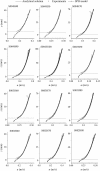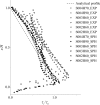SPH modelling of depth-limited turbulent open channel flows over rough boundaries
- PMID: 28066121
- PMCID: PMC5175435
- DOI: 10.1002/fld.4248
SPH modelling of depth-limited turbulent open channel flows over rough boundaries
Abstract
A numerical model based on the smoothed particle hydrodynamics method is developed to simulate depth-limited turbulent open channel flows over hydraulically rough beds. The 2D Lagrangian form of the Navier-Stokes equations is solved, in which a drag-based formulation is used based on an effective roughness zone near the bed to account for the roughness effect of bed spheres and an improved sub-particle-scale model is applied to account for the effect of turbulence. The sub-particle-scale model is constructed based on the mixing-length assumption rather than the standard Smagorinsky approach to compute the eddy-viscosity. A robust in/out-flow boundary technique is also proposed to achieve stable uniform flow conditions at the inlet and outlet boundaries where the flow characteristics are unknown. The model is applied to simulate uniform open channel flows over a rough bed composed of regular spheres and validated by experimental velocity data. To investigate the influence of the bed roughness on different flow conditions, data from 12 experimental tests with different bed slopes and uniform water depths are simulated, and a good agreement has been observed between the model and experimental results of the streamwise velocity and turbulent shear stress. This shows that both the roughness effect and flow turbulence should be addressed in order to simulate the correct mechanisms of turbulent flow over a rough bed boundary and that the presented smoothed particle hydrodynamics model accomplishes this successfully.
Keywords: SPH; drag force; inflow/outflow boundaries; open channel flow; rough bed; turbulence.
© 2016 The Authors International Journal for Numerical Methods in Fluids Published by John Wiley & Sons Ltd.
Figures

















References
-
- Nikora V, Koll K, McEwan I, McLean S, Dittrich A. Velocity distribution in the roughness layer of rough‐bed flows. Journal of Hydraulic Engineering 2004; 130:1036–1042.
-
- Nicholas AP. Computational fluid dynamics modelling of boundary roughness in gravel‐bed rivers: an investigation of the effects of random variability in bed elevation. Earth Surface Processes and Landforms 2001; 26:345–362.
-
- Smagorinsky J. General circulation experiments with the primitive equations. I. The basic experiment. Monthly Weather Review 1963; 91:99–164.
-
- Van Driest ER. On turbulent flow near a wall. Journal of the. Atmospheric Sciences 1956; 23:1007–1011.
-
- Rotta J. Turbulent boundary layers in incompressible flow. Progress in Aerospace Sciences 1962; 2:73–82.
LinkOut - more resources
Full Text Sources
Other Literature Sources
